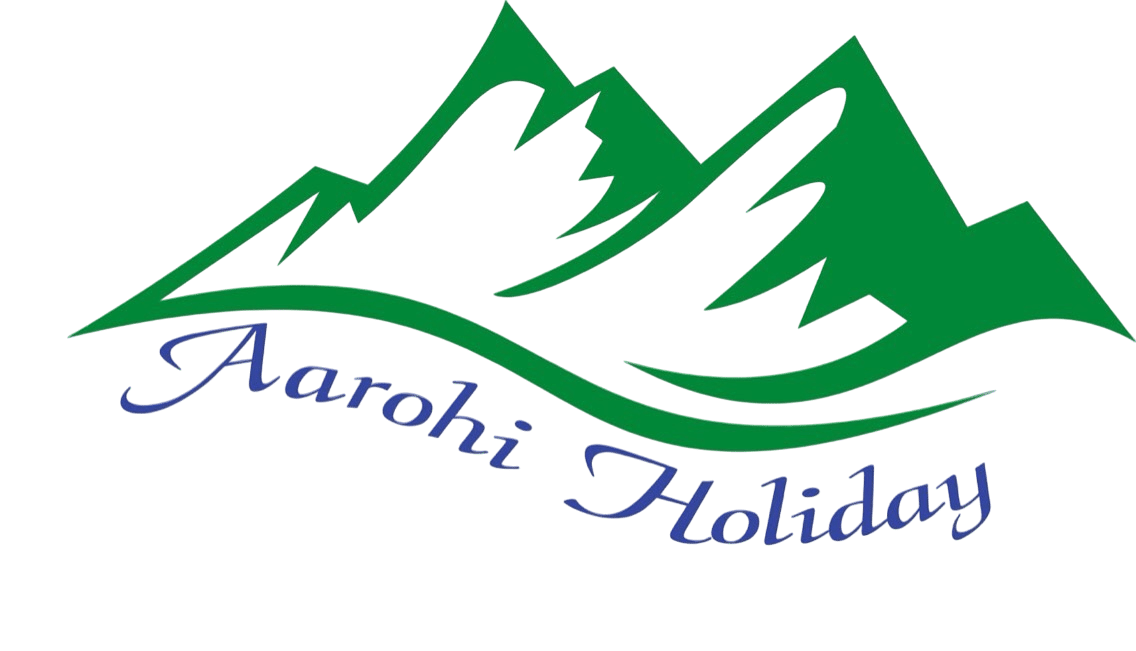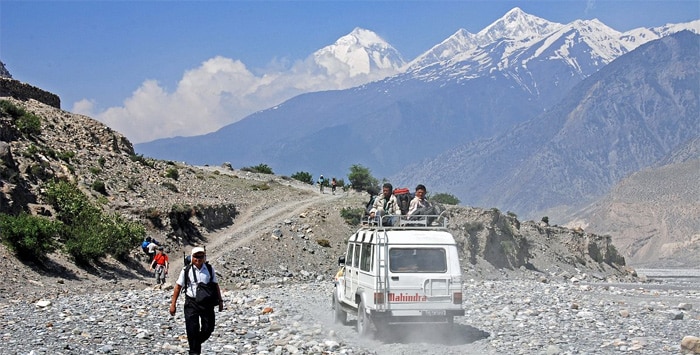Accommodation during Muktinath Tour By Jeep
- In Kathmandu and Pokhara we provide comfortable accommodation in 3-star hotels with breakfast on a twin-sharing basis.(Private room accommodation can be arrange at an extra cost)
- During the Muktinath Tour, we provide comfortable teahouse accommodation on a twin-sharing basis. Hot showers, Wi-Fi, and device charging are available at an additional cost.
Meals and Drinking water on Muktinath Tour By Jeep
During the tour, you will be provided with three meals a day: breakfast, lunch, and dinner served at local hotels, guesthouses, or restaurants along the route. The meals often include Nepali dishes like dal bhat (rice, lentils, and vegetables), along with options such as noodles, soups, bread, pasta, pancakes, and eggs. The food is simple, freshly prepared, and well-suited to keep you energized throughout the journey.
Staying hydrated is equally important. Bottled water and soft drinks are available for purchase along the way, but we recommend carrying a reusable water bottle to reduce plastic use. Our team can also provide water purification tablets or drops to make sure you have access to safe drinking water during the trip.
Required Permits for Muktinath Tour By Jeep
For the Muktinath Tour , you’ll need the Annapurna Conservation Area Permit and a TIMS Card—but don’t worry, we handle everything for you. All permit fees are included in your package, and we’ll take care of the paperwork so you can fully enjoy your trekking adventure.
- Annapurna Conservation Area Permit (ACAP): NPR 3,000 per person
- Trekkers’ Information Management System (TIMS) Card: NPR 1,000 per person
Best Time for Muktinath Tour By Jeep
The best time for the Muktinath Tour by Jeep is from March to May (spring) and September to November (autumn). During these seasons, the weather is clear and pleasant, with excellent mountain views and comfortable travel conditions. Spring also brings blooming flowers and greenery, while autumn is known for its stable weather and crisp skies.
Travel is possible throughout the year, but it is better to avoid the monsoon months from June to August, when heavy rainfall can cause roadblocks and reduce visibility. Winter (December to February) can be very cold in the higher regions, though the roads are usually open and the journey is still possible with proper preparation.
Muktinath Tour By Jeep Difficulties
The Muktinath Tour by Jeep is less physically demanding than trekking, as most of the journey is completed by road. However, travelers should be prepared for long driving hours on rough and uneven mountain roads. The journey can be bumpy and tiring at times, especially in remote sections where the road conditions are not smooth.
The maximum elevation of Muktinath is 3,800 meters, which may cause mild altitude-related issues for some visitors. It is important to stay hydrated and take the journey at a comfortable pace to minimize the risk. Weather changes can also affect road conditions, with monsoon rains causing landslides or blockages along the route.
While the tour is suitable for all age groups, it still requires patience, flexibility, and readiness to handle long drives and changing mountain weather. Proper warm clothing and a positive mindset will make the journey more comfortable and enjoyable.
Altitude Sickness and Prevention on the Muktinath Tour By Jeep
We prioritize your safety, even on moderate-altitude journeys like the Muktinath Tour by Jeep. Since Muktinath is located at around 3,800 meters, there is a chance that some travelers may feel mild altitude effects because of the quick gain in elevation by road. Our trained team focuses on prevention, first aid, and emergency support to ensure your journey stays safe and comfortable.
We take common symptoms of altitude sickness such as headache, dizziness, nausea, or shortness of breath very seriously. To prevent these, we encourage guests to drink plenty of water, eat light meals, and get proper rest during the trip. If needed, we can slow down the pace or arrange a descent for your safety. Before the journey begins, we provide a detailed safety briefing, and our guides remain attentive throughout to make sure you enjoy a smooth and memorable visit to Muktinath.
Travel Insurance for Muktinath Tour By Jeep
The Muktinath Tour by Jeep takes you through remote mountain regions, so having comprehensive travel insurance is highly recommended. Your policy should include emergency medical coverage and, if possible, evacuation services to ensure safety in case of unexpected incidents along the route.
Although the tour is less physically demanding than trekking, the journey involves long drives on rough and uneven roads, changing weather, and high-altitude areas. Having the right travel insurance gives you peace of mind, making sure that in case of illness, injury, or unforeseen delays, you can receive prompt assistance and enjoy your Muktinath adventure safely.
Muktinath Tour By Jeep Itinerary
The Muktinath Tour by Jeep begins with your arrival in Kathmandu at Tribhuvan International Airport, where our team will welcome you and transfer you to your hotel. On the following day, explore Kathmandu Valley, visiting major cultural sites such as Pashupatinath Temple, Boudhanath Stupa, Patan Durbar Square, and Swayambhunath. From Kathmandu, we drive to Galeshwar via Beni, passing through scenic villages, terraced fields, and riverside landscapes. The journey continues from Galeshwar to Jomsom, offering panoramic views of the Annapurna and Dhaulagiri ranges along the way.
On Day 5, we travel from Jomsom to Pokhara via Muktinath, stopping at key viewpoints and experiencing the spiritual ambiance of this sacred site. In Pokhara, enjoy some leisure time by Phewa Lake and explore the lakeside area. The tour concludes with a scenic drive back to Kathmandu and your departure on the final day. This journey combines cultural exploration, mountain landscapes, and a comfortable high-altitude adventure, making it an unforgettable Himalayan experience.
Muktinath Tour By Jeep Cost
The cost of the Muktinath Tour by Jeep depends on season and service level. Our 7-day Muktinath Tour by Jeep is priced at USD 750 per person, covering all essential services from Kathmandu to the departure day.
This price is based on a minimum of one person. For groups, we offer a 5% to 10% discount, and the group leader travels for free.
Important Notes for Muktinath Tour By Jeep
- The journey from Kathmandu to Muktinath by road takes about 10 to 12 hours, depending on weather and road conditions.
- A private jeep is included in this tour for comfortable and flexible travel.
- Meals are included during the tour at local hotels and restaurants. Extra charges apply for hot showers or charging devices.
- There are limited ATMs along the route, so carry enough cash before starting the journey.
- Porters are not required as luggage is stored in the jeep, but keep personal items in a small daypack for convenience.
- Drones require hard-to-get permits, so it’s best not to bring.
Fitness Preparation Muktinath Tour
Although the Muktinath Tour by Jeep is mostly a road journey and does not require strenuous trekking, some basic fitness preparation is recommended. Long hours of travel on mountain roads can be tiring, so building endurance through regular walking, light hiking, or cardio exercises will make the trip more comfortable.
Carrying a small daypack and moving around at stops along the route can also help you stay active and adjust to higher elevations. Most travelers who maintain general fitness can enjoy this tour comfortably and make the most of the scenic and cultural experiences along the way.
A Typical Day on the Trail
A typical day on the Muktinath Tour by Jeep involves long drives through mountain roads, rivers, and scenic villages. The day usually starts after breakfast, followed by travel in the jeep with stops at viewpoints, cultural sites, and small towns along the route. Although most of the journey is by vehicle, passengers can stretch their legs during breaks, explore local markets, and take photographs of the Himalayan landscapes.
Lunch and refreshment stops are included, allowing time to rest and enjoy the surroundings. Even though the tour does not involve strenuous trekking, the combination of road travel and occasional short walks at higher elevations makes it important to pace yourself, stay hydrated, and enjoy the journey comfortably.
Arrival Instruction
Upon your arrival at Tribhuvan International Airport, our company representatives are stationed to welcome you to the country. We request you to carefully look for your name being held by our representatives following the events upon landing. The representatives are responsible to escort you to your hotel in Kathmandu. You will see men offering you to carry luggage and take you to your destination as you exit the airport. We request you pay no attention to these people and follow the designated representatives and follow their instructions. You will also need to keep an eye on your luggage and belongings to avoid any complications.
Nepal Visa Entry Procedure
For entry into Nepal, there are visa requirements everyone (except Indian nationals) must complete before being allowed to pass through immigration. This is for air travel as well as overland transportation. Most visitors may obtain a visa to enter Nepal, however, there are exceptions. Three options are available for entry
- 15-day single entry: US $30
- 30-day single entry: US $50
- 90-day multiple entries: US $125
Please have a passport valid for at least 6 months from the time of entry, and have cash ready, preferably in US dollars, though there are other currencies Nepal Immigration accepts. If you are entering via overland, you must have US cash and 3 passport photos. For arrival by air, the kiosks at the airport take your picture for you.For the most up to date list of exceptions for visa on arrival or to obtain the most current visa information, visit the Nepal Department of Immigration website.


